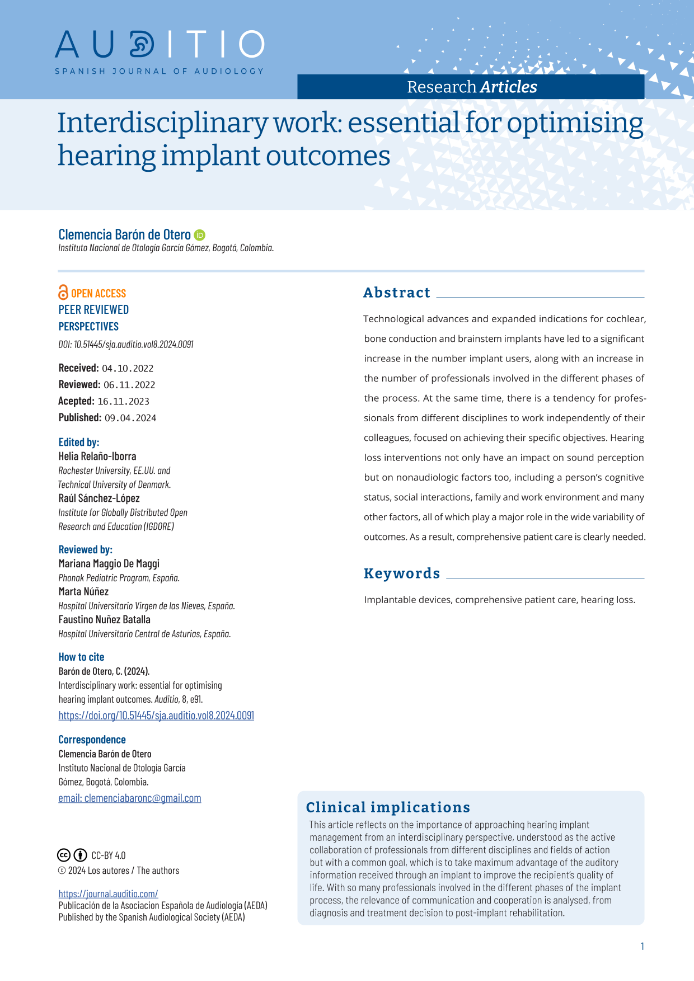Interdisciplinary work: essential for optimal results in auditory implants
DOI:
https://doi.org/10.51445/sja.auditio.vol8.2024.0091Keywords:
Implantable devices, comprehensive patient care, hearing lossAbstract
Technological advances and expanded indications for cochlear, bone conduction and brainstem implants have led to a significant increase in the number implant users, along with an increase in the number of professionals involved in the different phases of the process. At the same time, there is a tendency for professionals from different disciplines to work independently of their colleagues, focused on achieving their specific objectives. Hearing loss interventions not only have an impact on sound perception but on nonaudiologic factors too, including a person’s cognitive status, social interactions, family and work environment and many other factors, all of which play a major role in the wide variability of outcomes. As a result, comprehensive patient care is clearly needed.
Downloads
Visibility and Altmetrics
Metrics
Global Statistics ℹ️
|
1754
Views
|
2271
Downloads
|
|
4025
Total
|
|
References
Babiker A., El Husseini M. E., Al Nemri A., Al Frayh A., Al Juryyan N., Faki M. O., Assiri A., Al Saadi M., Al Zamil F. (2014) Health care professional development: Working as a team to improve patient care. Sudan J Paedi atr; 14(2):9-16.
Bavelier D., Neville H. (2002). Cross-modal plasticity: Where and how? Nature 3:443-452.
Bernard-Bonnin A. C., Stachenko S., Bonin D., Charette C., & Rousseau, E. (1995). Self-management teaching programs and morbidity of pediatric asthma: a meta-analysis. Journal of Allergy and Clinical Immunology, 95(1), 34-41.
Boisvert I., Reis M., Au A., Cowan R., & Dowell R. C. (2020). Cochlear implantation outcomes in adults: A scoping review. PLoS One, 15(5), e0232421.
Boyle, P. (2019). Electric Stimulation of the Auditory System. https://doi.org/10.5772/intechopen.85285
Choi B. C., Pak A. W. (2006). Multidisciplinarity, interdisciplinarity and transdisciplinarity in health research, services, education and policy: 1. Definitions, objectives, and evidence of effectiveness. Clin Invest Med.; 29(6): 351-64. PMID: 17330451.
Clark, G. (2013). Cochlear implants: fundamentals and applications. Springer: New York.
Cooper H., Craddock L. (2006). Cochlear Implants: a practical guide. John Wiley & sons: Oxford.
Corrales E., Oghlai J. (2013). Cochlear Implant considerations in children with additional disabilities. Curr Otorhinolaryngol Rep. 2013 Jun 1; 1(2): 61–68.
Cosetti M. K. & Waltzman S. B. (2012). Outcomes in cochlear implantation: variables affecting performance in adults and children. Otolaryngologic Clinics of North America, 45(1), 155-171.
Dihn J., Traylor A., Kilcullen M., Perez J., Schweissing E., Venkatesh A., Salas E. (2019). Cross-Disciplinary Care: A systematic review on Teamwork processes in health Care. Small Gropu Research 51:1, 125-166.
Dorman M., Gifford R. (2017). Speech Understanding in complex listening environments by listeners fit with cochlear implants. JSLHR, 60(10), 3019-3026.
Drouin J. & Theodore R. (2020). Leveraging interdisciplinary perspectives to optimize auditory training for cochlear implant users. Lang Linguist Compass, 14:1-18.
Garcia-García F., Lopez-Torrijo M. (2016). A short communication on the need for interdisciplinary action with families with deaf children who use bilateral cochlear implants. J Med Imo Surg, 16:1-3.
Institute of Medicine Committee on the Health Professions Education Summit. (2003). The core competencies needed for health care professionals In Greiner AC & Knebel E (Eds.), Health professions education: A bridge to quality, pp. 45–74. Washington, DC: National Academies Press.
Kim L., Jeong S.W., Lee Y. M. & Kim J. S. (2010). Cochlear Implantation in children. Auris Nasus Larynx, 37(1), 6-17.
Livingston G et al. (2020). Dementia prevention, intervention and care: 2020 report of the Lancet Commission. The Lancet; 396:413-446. https://doi.org/10.1016/S0140-6736(20)30367-6
Nasralla et al. (2018). Benefit of Cochlear implantation in children with multiple handicaps: a parent’s perspective. Int Arch Otorhinolaryngol; 22:415–427.
Parikh S. R., Machleder D. J., Chobot-Rodd J., Girouard K., Shanske A., Stern E., ... & Dinces, E. (2004). Building a multidisciplinary cochlear implant team. Einstein J. Biol. Med, 21, 19-24.
Ramos-Macias A., Borkoski-Barreiro S., Falcón-González J., Ramos de Miguel A. (2016). Implante Coclear. Estado actual y futuro. Rev Med Cl Los Condes.; 27(6), 798-807.
Roderick J. L. (2010). Deciphering Interdisciplinary and Transdisciplinary Contributions. Transdisciplinary Journal of Engineering & Science; Vol: 1, No:1.
Rodríguez W. F. L., Secín D.R., Ramírez A. J. L. (2021). El trabajo en equipo como parte de un sistema de salud. Acta Med.; 19(4):477-479.
Rosen M. A., Diaz Granados D., Dietz A. S., Benishek L. E., Thompson D., Pronovost P. J., Weaver S. J. (2018). Teamwork in healthcare: Key discoveries enabling safer, high-quality care. Am Psychol.; 73(4):433-450.
Sardone R., Battista P., Panza F., Lozupone M., Griseta C., Castellana F. et al. (2019). The age-related central auditory processing disorder: silent impairment of the cognitive ear. Front Neurosci.; 13:619.
Schmutz J. B., Meier L. L., Manser T. (2019). How effective is teamwork really? The relationship between teamwork and performance in healthcare teams: a systematic review and meta-analysis. BMJ Open.
Sharma S., Bhatia K., Singh, S., Lahiri, A. K. & Aggarwal, A. (2017). Impact of socioeconomic factors on paediatric cochlear implant outcomes. International Journal of Pediatric Otorhinolaryngology, 102, 90-97.
Soskolne C. (2000). Transdisciplinary approaches for public health. Epidemiology; 11: S122.
Warner-Czyz A., Roland T., Thomas D., Uhler K., Zombek L. (2022). American Cochlear Implant Alliance task force guidelines for determining cochlear implant candidacy in children. Ear & Hear; 43, 268-282.
World Health Organization (2016). Childhood hearing loss: strategies for prevention and care. Accessed: https://www.who.int/publications/i/item/childhood-hearing-loss-strategies-for-prevention-and-care
Xue L., Le Bot G., Petegem W., van Wieringen A. (2017). Defining interdisciplinary competencies for audiological rehabilitation: findings from a modified Delphi study, Int Jour Audiol; 1-12.
Ysunza A (2014). Audiologia, Otoneurologìa y Foniatría, la más interdisciplinaria especialidad médica. Rev Mex AMCAOF; 3: 5-6.
Zaltz Y., Bugannim Y., Zechoval D., Kishon-Rabin L., Perez R. (2020). Listening in Noise Remains a Significant Challenge for Cochlear Implant Users: Evidence from Early Deafened and Those with Progressive Hearing Loss Compared to Peers with Normal Hearing. J Clin Med.; May 8;9(5):1381.
Zajac S., Woods A., Tannenbaum S., Salas E. and Holladay C. L. (2021). Overcoming Challenges to Teamwork in Healthcare: A Team Effectiveness Framework and Evidence-Based Guidance. Front. Commun., 17 March 2021, v. 6. https://doi.org/10.3389/fcomm.2021.606445

Downloads
Published
How to Cite
License
Copyright (c) 2024 Clemencia Baron de Otero

This work is licensed under a Creative Commons Attribution 4.0 International License.
All articles will be published under the open Creative Commons Attribution (CC-BY) license. This license allows others to share and adapt the content, even for commercial purposes, as long as appropriate credit is given to the authors and the journal. By submitting their manuscript, authors retain copyright but grant the journal the right to make the first publication under this license.
More information about this license is available at: https://creativecommons.org/licenses/by/4.0/
Articles published between 2001 and 2020
The texts published in this journal in the section "AUDITIO 2001-2020" are subject - unless otherwise indicated - to a Creative Commons Attribution 3.0 Spain license. You can copy, distribute, communicate them publicly, make derivative works and commercial uses provided that you acknowledge the credits of the works (authorship, name of the journal, publishing institution) in the manner specified by the authors or by the journal. The full license can be consulted at http://creativecommons.org/licenses/by/3.0/es/deed.es.









